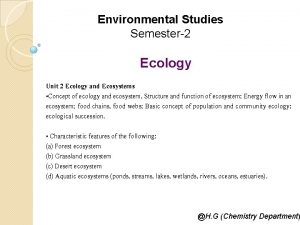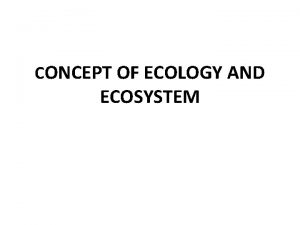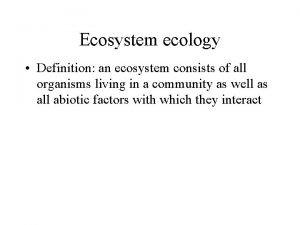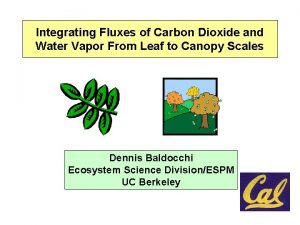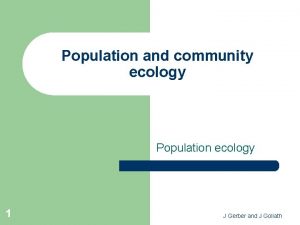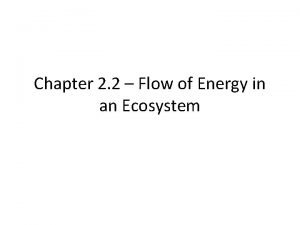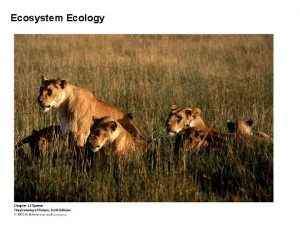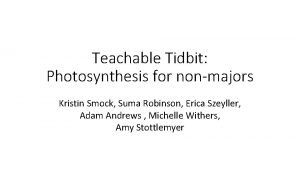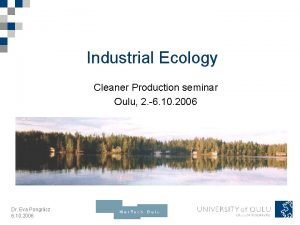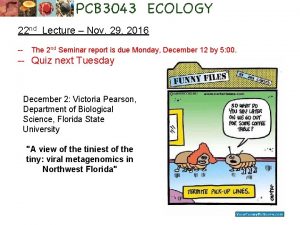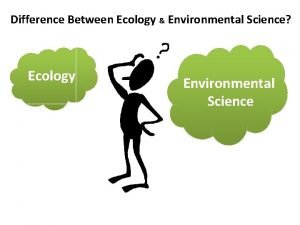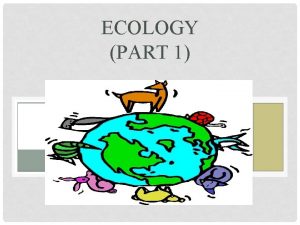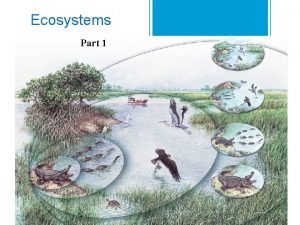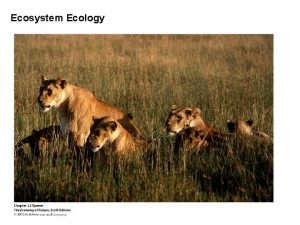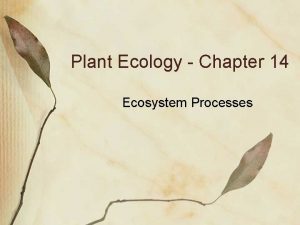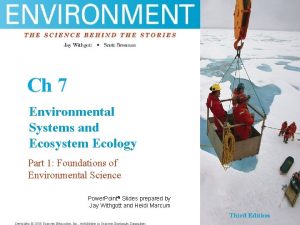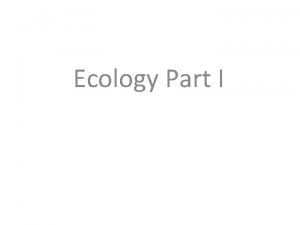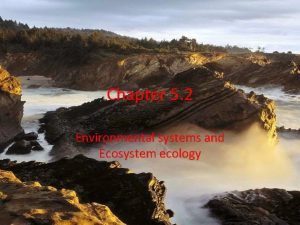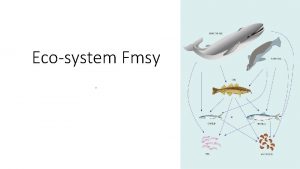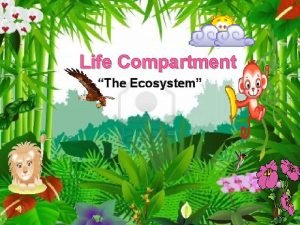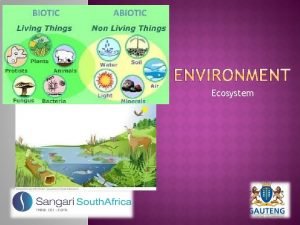7 Environmental Systems and Ecosystem Ecology Part A















- Slides: 15

7 Environmental Systems and Ecosystem Ecology Part A Power. Point® Slides prepared by Jay Withgott and Kristy Manning Copyright © 2006 Pearson Education, Inc. , publishing as Benjamin Cummings

This lecture will help you understand: • The nature of systems • Ecosystem-level ecology • Nutrient cycles: C, P, N • The hydrologic cycle • Plate tectonics and the rock cycle Copyright © 2006 Pearson Education, Inc. , publishing as Benjamin Cummings

Central Case: The Gulf of Mexico’s “Dead Zone” • Major fisheries off Louisiana were devastated by die-offs. • Scientists found large regions of low oxygen in the Gulf. • The recurring “dead zone” resulted from nitrogen pollution traveling down the Mississippi River. Copyright © 2006 Pearson Education, Inc. , publishing as Benjamin Cummings

Earth’s environmental systems • Our planet consists of many complex, large-scale, interacting systems. • System = a network of relationships among a group of parts, elements, or components that interact with and influence one another through the exchange of energy, matter, and/or information Copyright © 2006 Pearson Education, Inc. , publishing as Benjamin Cummings

Feedback loops: Negative feedback Feedback loop = a circular process whereby a system’s output serves as input to that same system In a negative feedback loop, output acts as input that moves the system in the opposite direction. This compensation stabilizes the system Copyright © 2006 Pearson Education, Inc. , publishing as Benjamin Cummings

Feedback loops: Positive feedback • In a positive feedback loop, output acts as input that moves the system further in the same direction. • This magnification of effects destabilizes the system. Copyright © 2006 Pearson Education, Inc. , publishing as Benjamin Cummings

Dynamic equilibrium, homeostasis • Dynamic equilibrium = when processes in a system move in opposite directions at equivalent rates so their effects balance out This can contribute to • Homeostasis = tendency of a system to maintain constant or stable internal conditions • Earth’s climate and an animal’s body are examples of homeostatic systems in dynamic equilibrium. Copyright © 2006 Pearson Education, Inc. , publishing as Benjamin Cummings

Emergent properties Properties of a whole system not evident in the system’s components “The whole is more than the sum of its parts. ” A tree is an element of a forest, a sink for CO 2, and habitat for birds. Copyright © 2006 Pearson Education, Inc. , publishing as Benjamin Cummings

Closed and open systems • Closed system = isolated and self-contained • Open system = exchanges energy, matter, and information with other systems • It is useful to think of Earth as a closed system. • But any system is open if we examine it closely enough or long enough. Copyright © 2006 Pearson Education, Inc. , publishing as Benjamin Cummings

An environmental system Mississippi River as a system: • Emergent properties • Input of water, fish, pollution, etc. • Output to Gulf of Mexico Copyright © 2006 Pearson Education, Inc. , publishing as Benjamin Cummings

Two systems or one? • The Mississippi River system and the system of the Gulf of Mexico interact. • Understanding the dead zone requires viewing the Mississippi River and the Gulf of Mexico as a single system. • This holistic kind of view is necessary for comprehending many environmental issues and processes. Copyright © 2006 Pearson Education, Inc. , publishing as Benjamin Cummings

Increasing nitrogen inputs Amount of nitrogen fertilizer used rose greatly, 1950– 80 Nitrate concentrations in Midwestern rivers in 1980– 98 were much more than in 1905– 07. Copyright © 2006 Pearson Education, Inc. , publishing as Benjamin Cummings

Eutrophication Key to the dead zone = Eutrophication: excess nutrient enrichment in water, which increases production of organic matter. . . … which when decomposed by oxygen-using microbes can deplete water of oxygen. Copyright © 2006 Pearson Education, Inc. , publishing as Benjamin Cummings

Creation of the hypoxic dead zone Nitrogen input boosts phytoplankton… …which die and are decomposed by microbes that suck oxygen from water, killing fish and shrimp. Copyright © 2006 Pearson Education, Inc. , publishing as Benjamin Cummings

Earth’s structural spheres • Lithosphere = rock, sediment, soil below Earth’s surface • Atmosphere = air surrounding the planet • Hydrosphere = all water—salt and fresh, liquid, ice, and vapor • Biosphere = all the planet’s living things, and the abiotic parts of the environment with which they interact Copyright © 2006 Pearson Education, Inc. , publishing as Benjamin Cummings
 Difference between ecosystem and ecology
Difference between ecosystem and ecology Difference between ecosystem and ecology
Difference between ecosystem and ecology Ecosystem ecology
Ecosystem ecology An ecosystem consists of
An ecosystem consists of Ecosystem ecology
Ecosystem ecology Ecosystem ecology
Ecosystem ecology Principles of ecology 2 flow of energy in an ecosystem
Principles of ecology 2 flow of energy in an ecosystem Ecosystem ecology
Ecosystem ecology Ecosystem ecology
Ecosystem ecology Ecology ecosystem
Ecology ecosystem Ecosystem ecology
Ecosystem ecology Difference of ecology and environmental science
Difference of ecology and environmental science Symbiosis examples
Symbiosis examples Ecology part 1
Ecology part 1 An ecosystem contains
An ecosystem contains Wireless health
Wireless health
